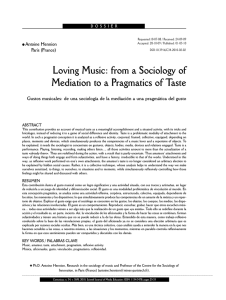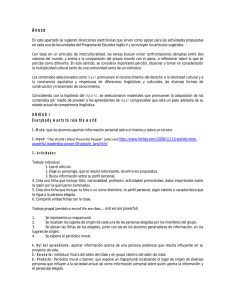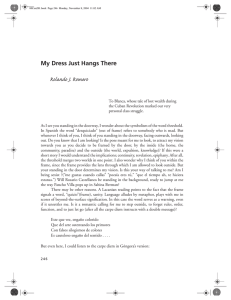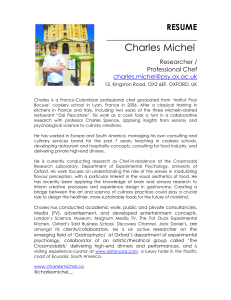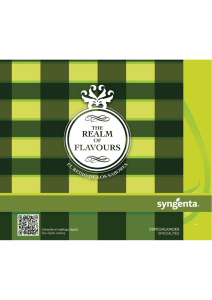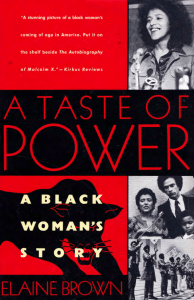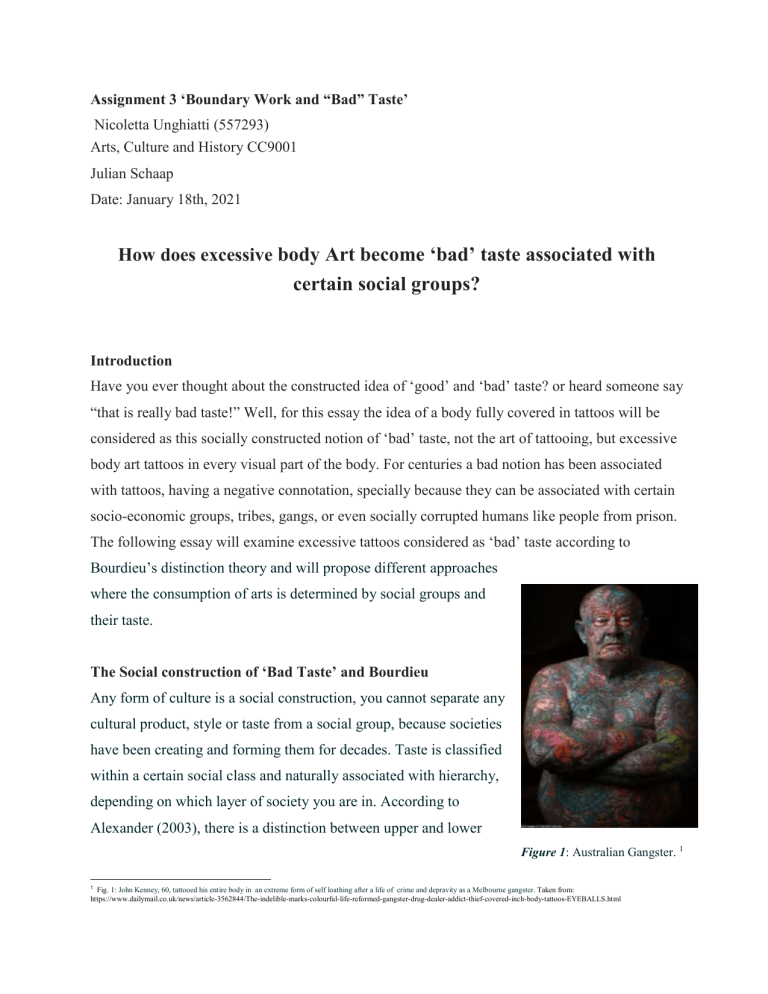
Assignment 3 ‘Boundary Work and “Bad” Taste’ Nicoletta Unghiatti (557293) Arts, Culture and History CC9001 Julian Schaap Date: January 18th, 2021 How does excessive body Art become ‘bad’ taste associated with certain social groups? Introduction Have you ever thought about the constructed idea of ‘good’ and ‘bad’ taste? or heard someone say “that is really bad taste!” Well, for this essay the idea of a body fully covered in tattoos will be considered as this socially constructed notion of ‘bad’ taste, not the art of tattooing, but excessive body art tattoos in every visual part of the body. For centuries a bad notion has been associated with tattoos, having a negative connotation, specially because they can be associated with certain socio-economic groups, tribes, gangs, or even socially corrupted humans like people from prison. The following essay will examine excessive tattoos considered as ‘bad’ taste according to Bourdieu’s distinction theory and will propose different approaches where the consumption of arts is determined by social groups and their taste. The Social construction of ‘Bad Taste’ and Bourdieu Any form of culture is a social construction, you cannot separate any cultural product, style or taste from a social group, because societies have been creating and forming them for decades. Taste is classified within a certain social class and naturally associated with hierarchy, depending on which layer of society you are in. According to Alexander (2003), there is a distinction between upper and lower Figure 1: Australian Gangster. 1 1 Fig. 1: John Kenney, 60, tattooed his entire body in an extreme form of self loathing after a life of crime and depravity as a Melbourne gangster. Taken from: https://www.dailymail.co.uk/news/article-3562844/The-indelible-marks-colourful-life-reformed-gangster-drug-dealer-addict-thief-covered-inch-body-tattoos-EYEBALLS.html classes related to the consumption of arts, where “highbrow is ‘one who has or affects superior learning or culture’ whereas a lowbrow is ‘one having uncultivated tastes’ ” (p.228). There are certain boundaries constructed by social systems between these different classes based on taste and aesthetic options. Thinking about high or lowbrow according to Bourdieu relates directly to what we have grown up to think about different social groups, so people completely tattooed for instance, tend to be associated with ‘bad’ taste as they have excessive and not refined consumption of body art. Consequently, ‘bad taste' was defined by high socio-economic groups as the dominant classes, being a concept merely associated with lower social classes, less capital and therefore, taste. About taste, we find Bourdieu’s distinction theory from his book Distinction (1984), which formulates that quality is strongly related to class, so people make judgments like ‘pretty or ugly’ classifying not only something, but also themselves, showing their belonging to a social group. Considering excessive body art tattoos as lowbrow (fig.1) means it is ‘bad’ taste as we are drawing boundaries by differentiating this group who uses tattoos all over their bodies. People higher educated in a sense, prefer fewer tattoos or minimal ones, they still have them, but they are not excessive or made in visual parts like the neck or face, they tend to be hidden because they know it is not socially acceptable to have that many. Kang and Jones (2007) find that “young people may find it necessary to cover their tattoos not only when looking for work but also on the job” (p. 46). Therefore, Bourdieu talks about forms of capital leading to these inequalities, and one of them is cultural capital, which means the accumulation of how you behave, your educational background and cultural preferences, which takes years and years. These preferences are mainly the artistic taste you have access to, like the amount of books, paintings and design products you have in your house for instance, or in this case, the amount of tattoos you also have acquired. Additionally, as a critique to Bourdieu’s distinction approach, Alexander (2003) says there are ‘cultural omnivores’ as “people who consume a selection of art, both high and popular” (p.231), as part of having high cultural capital with a broad range of taste, whereas people with lower cultural capital tend to be more univore, being more interested in tattoos as it is the most familiar way of covering their bodies. Consequently, tattoos reveal a certain identity that lower classes like to show off and feel that many tattoos are representative of their lifestyle and socioeconomic background. Nonetheless, related to how people categorize when they see something, they think it is ‘good or bad’ taste called symbolic boundaries by Lamont and Molnar in 2002, and we find these kinds of categorization processes predominantly in cultural and aesthetic categories. The kind of style something is, depends on the type of people establishing these trends, for example Adam Levine (fig. 2) as an excessive tattooed celebrity, is not considered to have ‘bad’ taste. So, probably higher social classes on one hand would agree with this idea of excessive tattoos as ‘bad’ taste, mainly people characterized as conservative from close upper circles, very concerned about what people think. They tend to discriminate more on how you look and behave in society, so having too many tattoos covering your body would not be considered ‘refined’ taste. Thereupon, according to Kang and Jones (2007) “despite their increasing popularity, tattoos still carry stigma and can provoke discrimination” (p.46). On the contrary, middle and lower classes would disagree more with this idea of tattoos as ‘bad’ taste, as many people covered in tattoos are just considered more authentic or care less about the ‘status quo, like celebrities, having renowned artists like Levine, looking almost the same as an ex-gang member (fig. 3). Nevertheless, there is a demarcated social stratification that determines they have ‘bad’ taste, so related to these layers in society forming inequality, we tend to see different kinds of tastes and identities from different stratas with distinctive preferences. Kang and Jones (2007) say that a “tattooed body serves as a canvas to record the struggles between conformity and resistance, power and victimization, individualism and group membership” (p.47). Therefore, as a social construction, there is no objective reality cataloged ‘good or bad’, but has more to do with the labels we assign to these practices and the things we often see around us. Figure 2. Adam Levine covered in tattoos. 2 Figure 3. Ex-gang member covered in tattoos. 3 Type of viewing style by McCoy and Scarborough Taste has also been examined by McCoy and Scarborough in 2014 by watching ‘bad’ television, making a distinction on how is this type of consumption, identifying three main styles of consuming; practicing “ironic consumption”, employing a “camp sensibility”, and viewing as a “guilty pleasure”. I believe that excessively tattooing your body as a ‘bad’ taste example fits best with the camp sensibility viewing style, which according to McCoy and Scarborough (2014), “the camp viewer reveres the cultural object for how bad it is and admires the vision and passion of the producer” (p.51). This means that the person watching knows that the show is objectively ‘bad’ but uses this type of sensibility to make it look even great, often admiring it. The same happens with people tattooing all their bodies, as they have a certain addiction and fascination for tattoos and their artists, the same as the camp viewers and the producers of the show, excessive tattooed people understand it has a negative image, but they have this idealization for tattooers. This idea is also discussed by Kang and Jones (2007) and it “is especially true for those who use tattooing to criticize the consumer values of capitalist society” (p.45), because they are demonstrating something or rebelling against certain institutions, so for them is kind of a celebration, just like the camp sensibility viewers. These hardcore forms of tattooing considered ‘bad’ taste compared to ‘bad’ television, have the same purpose, what people watch says something about them and how they want to be seen, in this case tattooed people are proud of their body art, they identify with this form of art by communicating their status. There is certain admiration to each tattoo made, as every tattoo tells a story or has an important significance. Linking the symbolic display of ‘bad’ taste to Goffman Concerning this notion of ‘bad’ or ‘good’ taste as a social construct, Erving Goffman talked about the social construction we made of ‘the self’, and how a great part of us is determined by society and the world surrounding us, so he refers to a dramaturgical perspective where every person is constantly acting or performing according to their context or situation. Macionis and Plummer (2012) defined this performance as a self presentation, or “an individual’s effort to create specific 2 3 https://www.capitalfm.com/features/tattoos-celebrity/adam-levine/ https://www.booooooom.com/2016/11/02/powerful-portraits-of-ex-gang-members-with-tattoos-digitally-removed/ impressions in the minds of others”(p.221), seeing life as a stage, where you also have verbal and non-verbal communication, like tattoos. In consequence, humans assume roles that are expected, we automatically split from one role to another without knowing. So Goffman was aware of the ‘backstage’ and ‘frontstage’ behaviours, conceptualizing life as a play where we meet constantly with people’s expectations and observations. This dramatic life described by Goffman is strongly related to the symbolic display of ‘bad’ taste, as something that people have to show or hide, as Kang and Jones (2007) say that “tattooing is especially popular among teenagers... a stage when young people are seeking to assert their independence, tattoos may provide a way to ground a sense of self in a seemingly changing and insecure world” (p.42). Therefore, these kinds of interactions influence everyone’s self-image forming their personalities, when we interact we play a certain role unconsciously, so how people respond and relate to us, is how we feel about ourselves and that makes us construct a certain ‘self’ or version of us. People completely tattooed have an individual identity, they want to differentiate with their bodies covered in tattoos, not because they consider it art, but because it says something about their lifestyle. Conclusions It seems we judge people by their ‘good’ or ‘bad’ taste and that is essentially the same thing as social class differentiation, we may see it in different terms, being interpreted as something that has a lot to do with individual choices. We do not see social class in everyday life, but we do see different choices in taste, habits or styles more evidently. The case of being completely covered in tattoos can be socially considered as ‘bad’ taste being connected to lowbrow culture, as we have analyzed previously. So, someone's taste can demonstrate social group belonging, depending on what they like, buy or wear. Moreover, we tend to associate people with excessive body art as people with lower taste, according to Bourdieu’s distinction. In sum, it is relevant how tattooed people present themselves socially being proud of their artistic choices and also where they normally gather, makes me wonder if I have classmates in university covered in tattoos? Maybe, I will never know because I haven’t seen any or because they hide it so well, as they have to maintain a certain cultural capital appearance. References Alexander, V. (2003). Sociology of the Arts: Exploring fine and popular Forms. Oxford: Blackwell Publishing, 225-243. Jones, K., & Kang, M. (2007). Why do people get tattoos? Contexts, 6 (1), 42-47. DOI: ctx.2007.6.1 Macionis, J., & Plummer, K. (2012). Sociology: A Global Introduction (5th edition). England: Pearson Education Limited. McCoy, C., & Scarborough, B. (2014). Watching ‘bad’ television: Ironic consumption, camp, and guilty pleasures. Poetics, 47, 41–59. http://dx.doi.org/10.1016/j.poetic.2014.10.003


